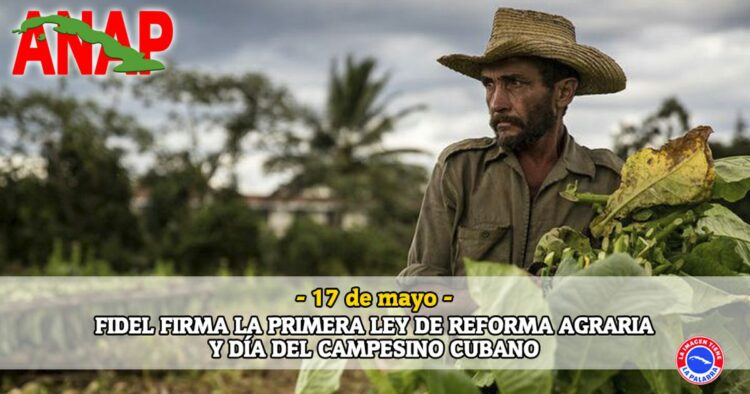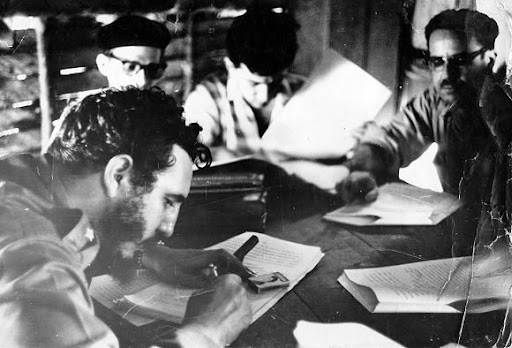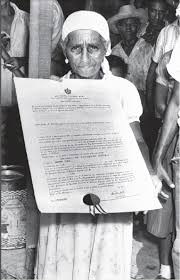
Havana, May 17.- The promise was fulfilled. Years of suffering ended when Commander in Chief Fidel Castro signed the already promised Agrarian Reform Law on May 17, 1959 during his self-defense plea in the trial for the assault on the Moncada Barracks, recognized as History will absolve me.
Inside a hut with jagua walls, guano roof and dirt floor, a few meters from the General Command of the Rebel Army in La Plata, the Sierra Maestra, the first law of the Revolutionary Government was promulgated. The phrase promised land seems like hyperbole in the middle of this writing, but it is not. His vision extends to those years where a new beginning was written for the Cuban peasantry. The exploitation ended.

The path already marked before was illuminated when more than 100,000 families of the rural population were lifted out of misery, landownership and imperialist domination were eliminated in our lands.
The situation was difficult. The years already passed left in their wake a balance of wealth that was unbalanced due to the great concentration of land ownership: 1.5% of the owners owned more than 46% of the area. Vast extensions of arable land were wasted on large farms, livestock exploitation, and other spaces that were completely uninhabited or covered with marabou were being wasted in the face of necessary productive activity.
The 1930s witnessed illegal evictions carried out by private and foreign companies, which constituted the starting point for the peasant uprising. The events of Realengo 18 are living testimony of these struggles. On the other hand, in the 1940 Constitution a law was approved that finally annulled the latifundium, but which, to the frustration of many Cubans, was left unimplemented.
What then was left for the people? Dying slowly and sadly of agony in his precarious existence and accepting that this was his life. Only a revolutionary process like this could confront the already exhausting situation. The signs were clear and announced the end to so much poverty. In 1890 José Martí had alluded to the need for agrarian reform, and as a result the bases for the route agreed in the Moncada Program were laid.
It was not a mere coincidence. The revolutionary people needed a change, a new beginning guided by the dream for which hundreds of Cubans died: achieving economic, political and social freedom. And it was fulfilled. The first Agrarian Reform Law, signed 65 years ago, put an end to so many periods of suffering, illegal evictions, unemployment and raised the right of peasants to land: a process that granted around 32 thousand families property titles.

The law had 15 articles, 67 articles, 7 transitional provisions and a final provision. The latter conferred constitutional status on the Agrarian Reform Law by declaring it part of the Fundamental Law of the Republic.
Its lines sought to achieve greater growth and diversification of the Cuban industry, and the elimination of dependence on agricultural monoculture. The emergence and extension of new crops that satisfied the needs and raw materials to provide food; It would raise the consumption capacity of the population, the standard of living of the inhabitants of rural areas, it would contribute to expanding the internal market and expand the lines of agricultural production destined for export as a source of foreign currency for the necessary imports.
Likewise, the Law indicated that large-scale, extensive and uneconomic production was an evil that had to be uprooted and replaced by cooperative, technical and intensive production that implies a rapid increase in production.
Goodbye to private property. Its implementation invested in social hierarchies that granted a large number of peasants and agricultural workers positions within the National Institute of Agrarian Reform (INRA), formed to apply the new agrarian laws, under the direction and administration by the peasants themselves who only months before They were at the lowest level of the social order.
The process was not alone. It brought with it a strong wave of development that, in the hands of INRA, reached these rural areas, building houses, towns, schools and hospitals, and in which the peasants themselves participated. In addition, it promoted access to education, because in those places where previously the children of peasants barely attended third grade, they began to complete school and even continue their university studies in the cities.
This date was then established as Farmer's Day and two years later, on May 17, 1961, the National Association of Small Farmers (ANAP) was created. History also records, when in 1963 a second Agrarian Reform law was approved that established the nationalization, and consequently the allocation to the Cuban State, of all rural properties with an area greater than sixty-seven hectares and ten areas (five caballerias). of Earth).
On this day of celebration for the Cuban peasantry, what we remember as “agrarian reform” brought with it a whole chain of changes, processes, transformations that paved the way for the Revolution and improved the living conditions of Cuban peasants. That May 17, 1959, Fidel put an end to decades of exploitation, subjugation and injustice and prioritized the right of men to maintain what was rightfully theirs.
To all of them, congratulations! (Text and photo: Digital Workers)